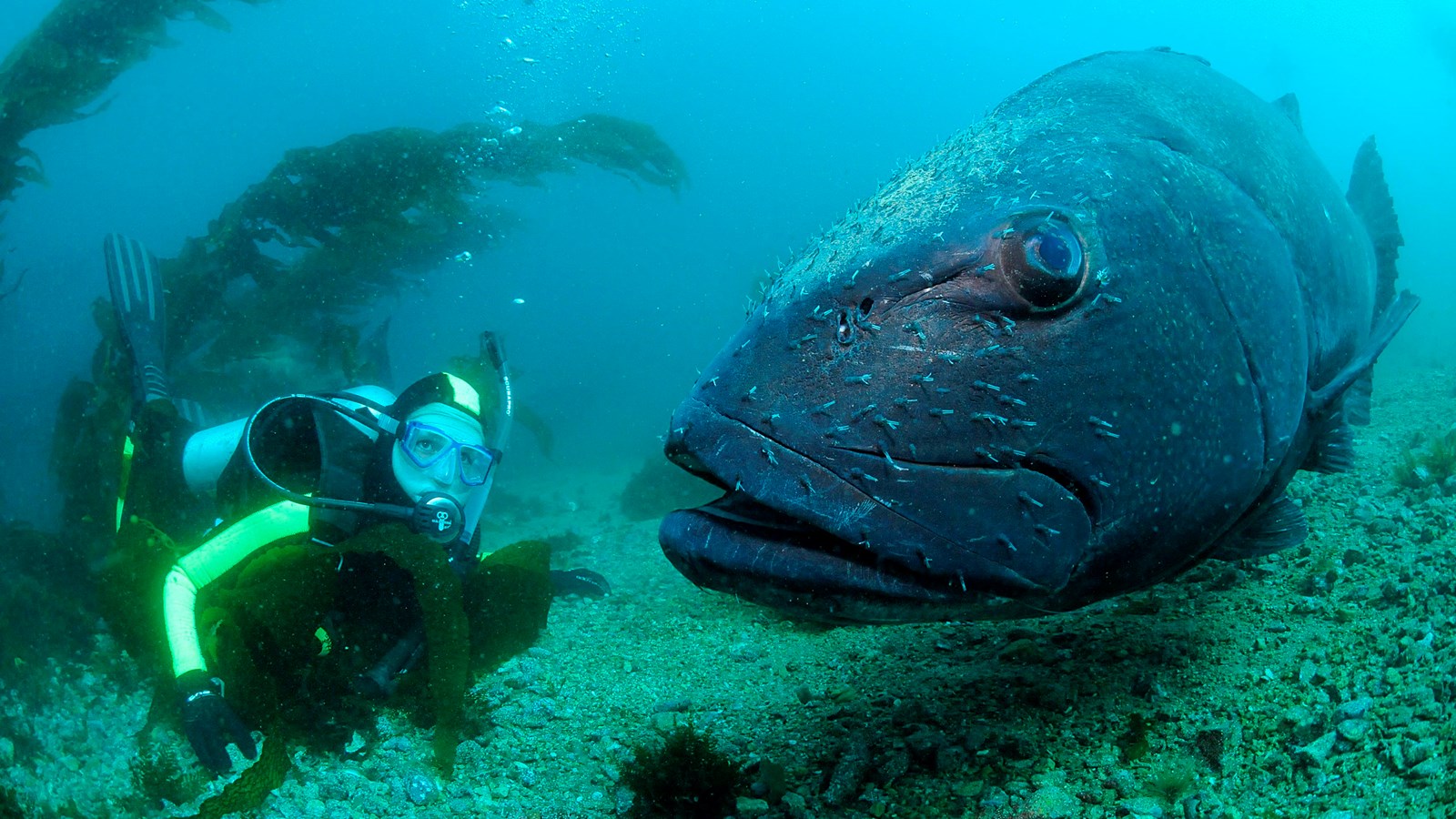Last updated: May 21, 2021
Place
Giant (Black) Sea Bass

Jeffrey Bozanic
Scientific Name
Stereolepis gigas
Introduction
The Giant Black Sea Bass is a unique species if not for any other reason than its extraordinary size. Its presence in the waters off of California and Baja California has played an important role in the health of the ecosystem in which it lives. With a position at or near the top of the food chain, it provides the balance required for an optimum marine environment. Prior to the 1950’s, this species of bony fish was very common to the near shore waters of Southern California. Due to over-fishing, their population was reduced to critically low levels. Back as far as the late 1970’s, the California Department of Fish and Game made it illegal to spearfish these giants. In 1982, both commercial and sport fishing of Giant Black Sea Bass was banned in California waters.
Quick and Cool Facts
- It is estimated that the Giant Black Sea Bass is capable of growing to lengths of over 7 feet and weighing over 700 pounds.
- The largest species ever caught by a sport fisherman with rod and reel, weighing 563 pounds, was caught off of Anacapa Island in 1968. 5
- Up to 60, 000, 000 eggs are produced by the female during the spawning season. 6
- Giant sea bass was originally assigned to the grouper family, Serranidae, but was later placed in a new family called the Percichthyidae.7
As implied by its alternative name of giant sea bass, the most dramatic feature of this fish is its conspicuous size, capable of growing over 700 pounds! The bulky, robust fish has a large mouth, small teeth and a distinctive single, strongly-notched dorsal fin (4). Almost as impressive as its size is the variation in color displayed by this species. Juveniles start out life as a bright orange color with black spots, with the orange turning a more bronzy purple as the individual grows and the spots fading as the fish gets darker. Large adults often appear solid black to grey, with a white underside, but retain the ability to display large black spots. Indeed, black sea bass are in fact capable of rapid and dramatic color changes, from dark above and light below to displaying white mottling or simply changing from jet black to pale grey. These color changes are thought to act as a form of communication between individuals or to be an indication of stress. 1
Range
According to the Pfleger Institute of Environment Research, the giant (black) sea bass range from Humboldt Bay to the tip of Baja California, and occur in the northern half of the Gulf of California. Within California this species is rarely found north of Point Conception. “PIER sponsored research from 2000 to 2005 focused on documenting the movements of giant sea bass around the northern Channel Islands. PIER researchers placed acoustic tags in giant sea bass within PIER’s Channel Islands Acoustic Receiver array. The study revealed that many of the giants leave Anacapa Island during the winter months and return in May or June while others remain at the island year round. Data on the seasonal movement patterns, spatial distribution, feeding habitats and potential spawning aggregation locations have been compiled and are awaiting publication. ” 4
Habitat
Adult giant sea bass seem to prefer the edges of near shore rocky reefs (35 to 120 feet) and are often associated with kelp beds. At certain times of the year adults can be found well away from the reef, foraging over sandy bottom and routinely associated with spawning squid. 4
Feeding
“The most important prey items of the giant (black) sea bass’, based upon research by PIER, 4 “are sting rays, skates, lobster, crabs, various flatfish, small sharks, mantis shrimp, blacksmith, ocean whitefish, red crab, sargo, sheephead, octopus, squid and an occasional kelp bass or barred sand bass. Giant sea bass are not built for sustained speed, and the vast majority of their prey is organisms that live on the bottom. These organisms, located crawling across the substrate or buried just below the surface, are drawn into the mouth of a giant sea bass by the vacuum produced when the huge mouth is rapidly opened. Certainly some mid-water fish are ambushed and sucked in by giant sea bass lurking in the shadows of the kelp.” 4
Reproduction
As shown in a study by Sepulveda, C., S. Aalbers. 2009. "The Giant Sea Bass: Status of Biological Knowledge” , “Male giant sea bass reach sexual maturity at about 40 pounds, while females mature at sizes of 50 to 60 pounds. These sizes correspond to an age of 11 to 13 years for either gender. During a three mouth spawning period from July to September, females may produce up to 60,000,000 eggs. After fertilization, the eggs absorb water and swell up, measuring up to 1/24th of an inch in diameter. Eggs are positively buoyant and float to the surface. After hatching, larvae drift and feed on plankton for about a month until they sink and start their juvenile phase.”6
Conservation Status
Based upon a 2008 assessment, the International Union for Conservation of Nature and Natural Resources, (IUCN), states that the Giant Black Sea Bass was classified as a Critically Endangered species by IUCN in 1996. This assessment presents additional information to support that assessment. The American Fisheries Society classified the species as Threatened. 7
References and Additional Information
